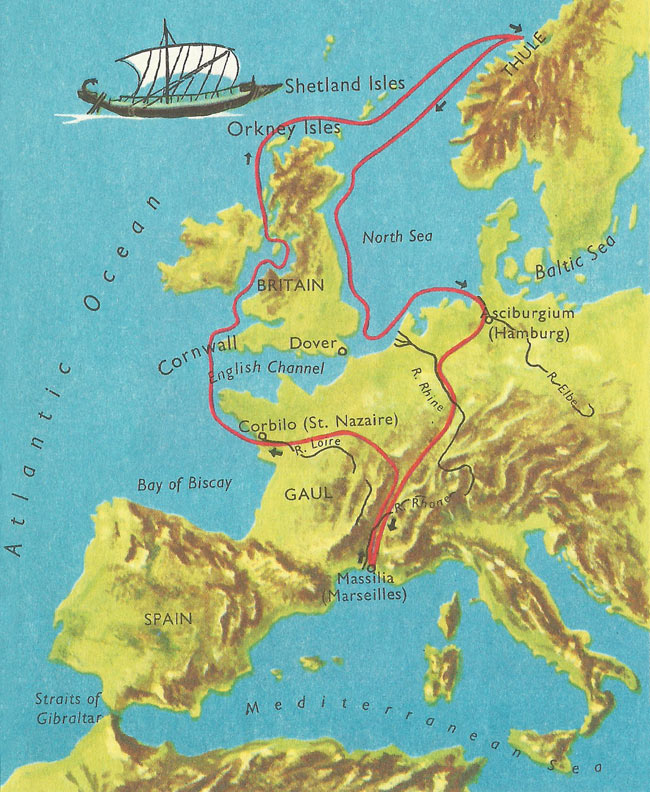Pytheas

The route followed by Pytheas.
Pytheas, a Greek from Marseilles, was the first explorer of Britain and the first Mediterranean traveller to visit the far north or Europe. His journey, 300 years before Christ, was a most remarkable and courageous voyage of discovery, for her explored regions totally unknown to the ancient world, with no maps, no compass, no guide except the sun and stars.
At the time of his voyage the Greek colony of Massilia, now Marseilles, was growing in wealth and importance. Its chief trading rival was Carthage, the great Phoenician city in North Africa. The Carthaginians had blockaded the Straits of Gibraltar to prevent the ships of other countries reaching the islands of the Atlantic, the sources of tin, copper, and gold. The merchants of Massilia, eager for a share in this rich trade, needed alternative trade routes and information about northern Europe. They therefore financed an expedition led by Pytheas which might provide them with this information.
Pytheas was more than a seaman and trader. He was a highly intelligent man, and astronomer, and a keen observer with real scientific curiosity. He observed how the days lengthened as he sailed north, and took heights of the sun at different places, from which later astronomers could work out their latitudes. He also noted that there is no star exactly over the North Pole.
Pytheas must have crossed Gaul about 330 BC by the trade route following the Rhone and the Loire to the Atlantic coast. From a Breton port he crossed to Cornwall and sailed round Britain. Which course he took, and where he landed to explore the country, cannot be known exactly, but he realized that Britain was roughly a triangle, made a reckoning of the lengths of the sides, and named the three corners Cape Belerion (Land's End), Kantion (Kent), and Orcas (opposite the Orkneys). He also sighted Ierne (Ireland), and island whose people were said to be wild and savage.
The people of Britain, Pytheas said, were numerous, with many chiefs who used chariots in warfare. They painted or tattooed their skins blue and lived in small dwellings made of logs and thatch. They threshed their corn indoors, in large barns, as the climate was dull and rainy, and stored the grain in cellars, to be ground when bread was needed.
Pytheas found the people in Cornwall more civilised than the rest, because of their contact with foreign tin traders. They dug the valuable ore with much skill, and carted it at low tide, or shipped it in boats made of hide, to an island called Ictis. (Ictis, which is a Celtic name, may be St Michael's Mount.) The tin was then shipped across to Gaul and taken on horseback to Massilia.
His discoveries
Pytheas was interested in the movements of tides, and wrote that the sea round Britain rises 80 cubits (120 feet). He may have meant the tides in the Bristol Channel, which rise about 60 feet, or the high tides in stormy weather in the Pentland Firth. Pytheas was the first man to connect the tides with the influence of the moon, although he could not explain exactly what happened.
Pytheas wrote of northern lands where animals were scarce, or non-existent, and where there was no corn except oats and only wild fruit, vegetables, and roots. He also mentions a distant island, Thule, six sailing days north of Britain and only one from the 'frozen' or 'curdled' sea.
Where was Thule? Pytheas may have meant the Shetlands, but it seems more likely that Thule was north Norway or Iceland, which he would have heard of on his travels, even if he never went there.
Before returning home, Pytheas wanted to discover where amber came from. It was known that this much-prized substance came from the northern coasts and islands of Europe, and Massilia had trading outposts as far north as the lower Rhine, but no Mediterranean traveller before Pytheas had reached Germany by sea. He mentions tow tribes, the Gutones and Teutons, living on a stretch of tidal coast, and on an island called Abalus, probably Heligoland. Here amber was washed ashore by the tides every spring, and sold by the people of the island and coast. It is typical of Pytheas that he found out the origin of amber, which is formed from the resin of pine trees, condensed by cold and sea water. The early Greeks had believed amber to be congealed sea-foam, or even sweat shed by the sun!
We cannot follow Pytheas beyond the River Elbe, and nothing is known of his journey home. He wrote a book called On the Ocean on his return, but all that remains are the fragments quoted by Greek geographers, especially Polybius, writing 100 years later, and Strabo, writing 300 years later.
These Greek writers made it clear that in their opinion Pytheas was a liar and braggart. And indeed it must have been hard for them to believe in a fertile, corn-growing Britain which was farther north than South Russia where the regions of frozen waste were supposed to begin. But today there is no reason to doubt his story, and he must be honoured as a great explorer and geographer.
